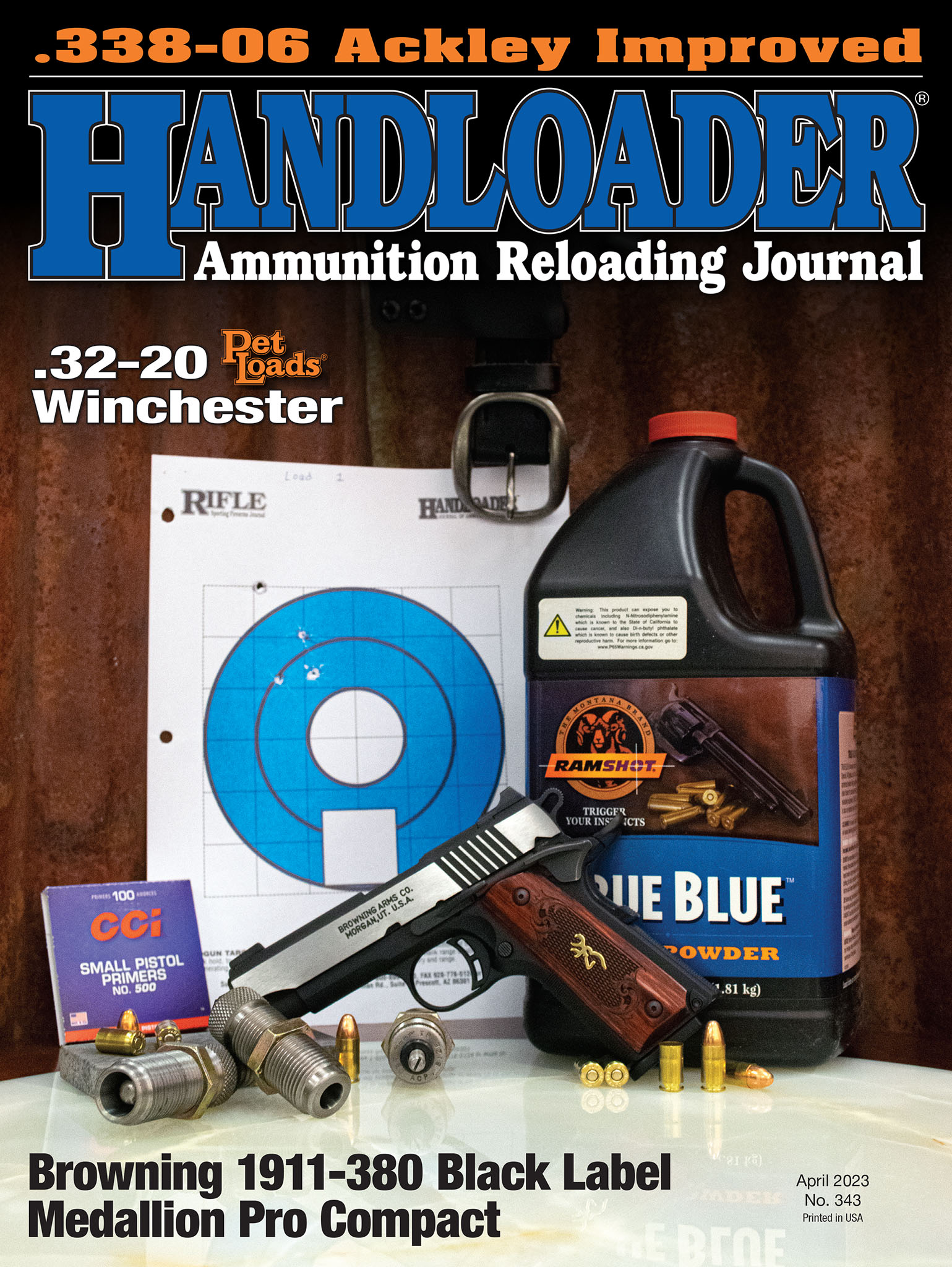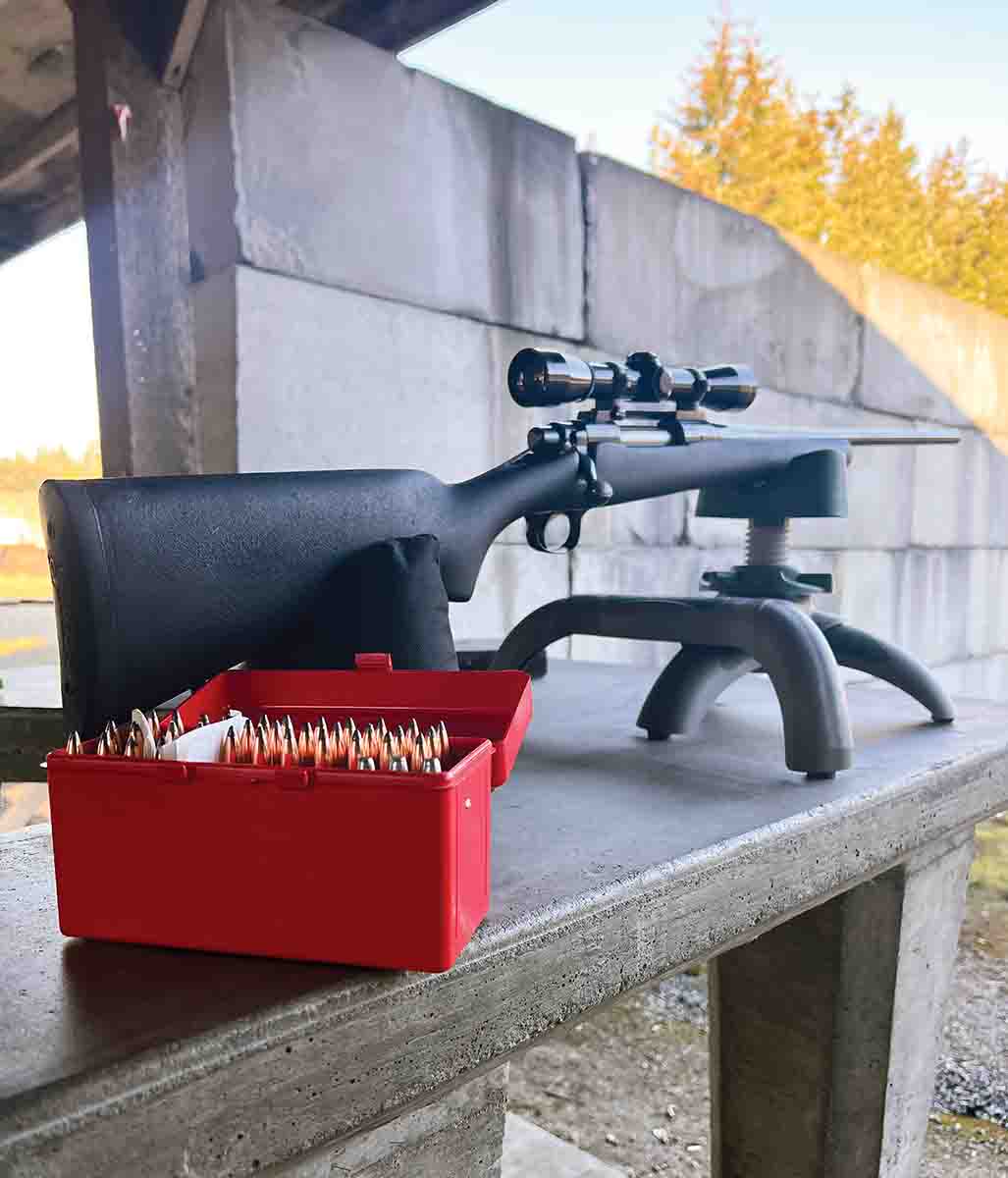
The Remington ADL chambered in .338-06 AI with Speer 200-grain spitzer softpoint bullets.
I wanted to write about one of the most underrated big-game cartridges that never caught on like it should have, the .338-06 Ackley Improved (.338-06 AI). For some reason, I’ve wanted this cartridge ever since I first heard about it. But then again, I am a sucker for anything based off of America’s well-rounded cartridge, the .30-06 Springfield.
First, a little history. The .338-06 AI comes from two different existing cartridges – the .30-06 Springfield, being the parent case, and the .338-06 A-Square, which originated from wildcatters in the late 1950s by necking up the case to fit a .338-diameter bullet. The A-Square company was founded by Lt. Colonel Arthur B. Alphin in 1979, and during the 1980s, the .338-06 was adopted by the company, which specialized in semi-custom rifles and ammunition. The cartridge was standardized as the .338-06 A-Square with the Sporting Arms and Ammunition Manufacturers’ Institute (SAAMI) in 1998 by the A-Square company.
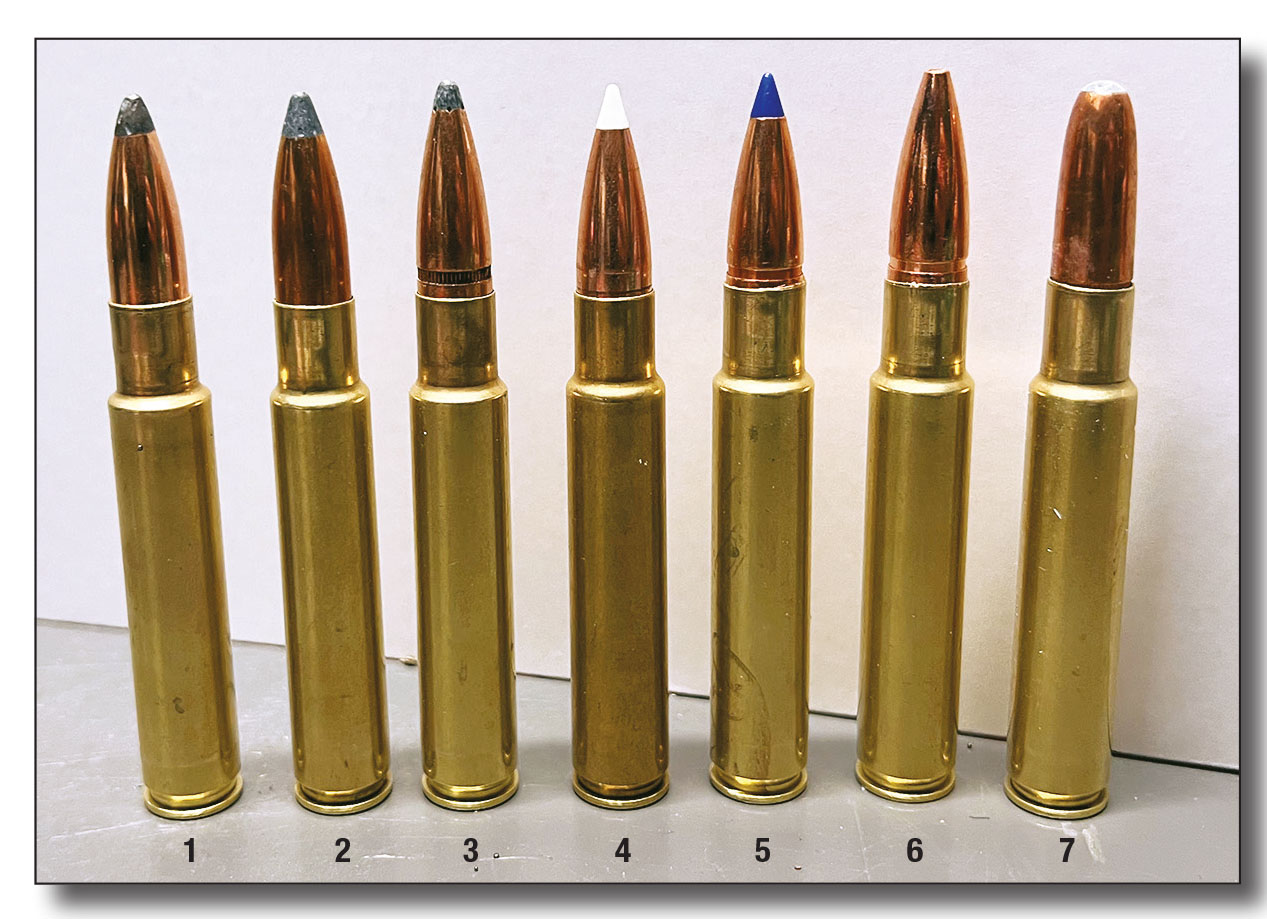
The .338-06 AI loaded: (1) Speer 200-grain spitzer softpoint, (2) Speer 225-grain softpoint BT, (3) Nosler 225-grain AccuBond, (4) Barnes 225-grain TTSX, (5) Barnes 225-grain TSX, (6) Hornady 225-grain InterLock SP-RP and (7) Hornady 250-grain InterLock RN.
The .338-06 AI is the same cartridge as the .338-06 A-Square but with a sharper shoulder of 40 degrees. This increases its case capacity allowing more powder into the case, which in turn increases the velocity. The .338-06 A-Square’s water capacity in a Remington case is 69.1 grains. The .338-06 AI water capacity in a Remington case is 72.1 grains, making for a 3-grain difference in case capacity. That’s not much, but it does allow for more powder to provide a little extra velocity. Plus, there is always the cool factor of the shoulder on an AI case. P.O. Ackley was a notable gunsmith, famous for developing wildcats from parent cartridges like the .30-06 Springfield. Maybe the most recognized one is the .280 AI, which comes from the .280 Remington and the same parent case, the .30-06 Springfield.
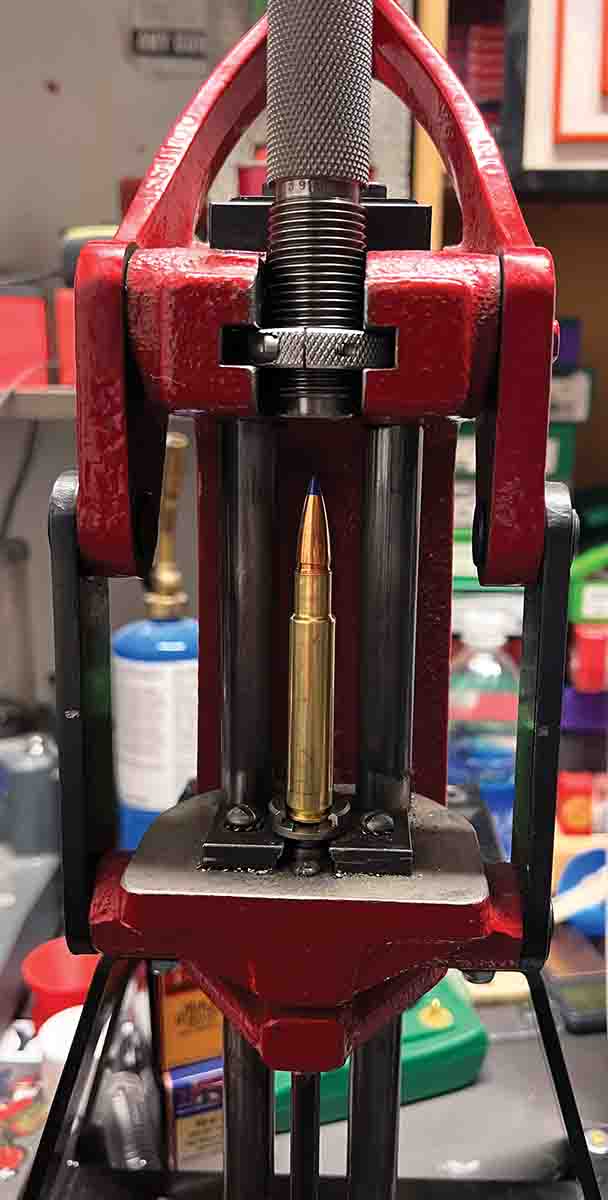
Seating a Barnes 225-grain TTSX in a Forster Co-Ax Press. The same press was also used to prime cases and offers excellent control.
The .338-06 AI makes for a great big-game cartridge, as it lets the shooter use heavy bullets from 180 to 250 grains. When in areas that have big, brown bears or elk, the .338-06 AI provides big-game performance without having to use a magnum cartridge. However, for those who load the lighter 180-grain bullet, it then turns into a deer slayer. With a 180-grain Nosler AccuBond bullet going about 2,800 feet per second (fps), it will put down any size deer with a well-placed shot and little to no meat waste. The .338-06 AI shoots relatively flat out to 400 yards with a G1 ballistic coefficient (BC) of .372 and a sectional density of .225. It is similar to the .35 Whelen, but what separates the two is that a .338-06 AI can use longer, sleeker bullets gaining up to 100 fps in velocity. With the .35 Whelen, shooting a Hornady 250-grain InterLock SP-RP (Spire Point-Recoil Proof) with a G1 BC of .375, it has a velocity of around 2,450 fps. Using the same bullet design from Hornady, but in .338 caliber, the 250-grain InterLock SP has a G1 BC of .431 and a velocity of around 2,600 fps with the .338-06 AI. There are higher BC bullets for the .338-06 AI, like the Hornady BTHP Match with a BC of .670, which is a great match bullet, but not a hunting bullet. Nosler also offers some great options as well, like the AccuBond 250-grain bullet with a BC of .575 and a sectional density of .313 – outstanding for a hunting bullet. Barnes also offers a great hunting option with the 225-grain, all-copper TTSX bullet with a BC of .514, a velocity of around 2,650 to 2,750 fps and a sectional density of .281.
The .338-06 AI performs closely to the .338 Winchester Magnum, using bullets weighing 180 to 250 grains. The .338 Winchester Magnum does average about 100 fps faster at the muzzle with velocities around 2,650 to 2,750 fps. When both cartridges are zeroed at 200 yards, using the same Nosler AccuBond 250-grain bullet at 400 yards, the drop on the .338-06 AI is 24.91 inches with 2,262 foot-pounds (ft-lbs) of energy. The .338 Winchester Magnum drops 22.89 inches at 400 yards with 2,461 ft-lbs of energy. As can be seen, there is about a 2-inch difference in drop and 200 ft-lbs between the two cartridges.
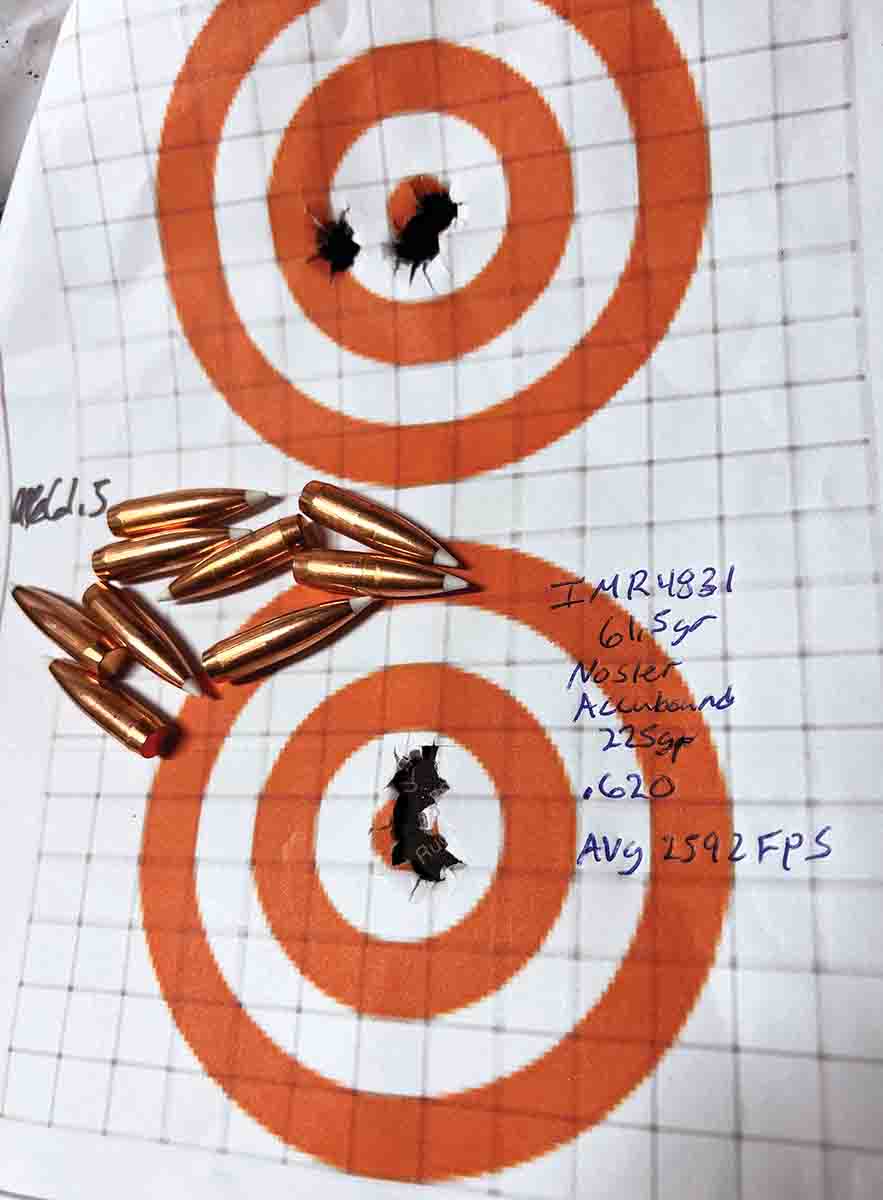
A target of the best group shot with Nosler 225-grain AccuBond bullets using IMR-4831 powder and Federal 210 primers. It had a group size of .620-inch average and 2,592 fps.
One big bonus to the .338-06 AI over the .338 Winchester Magnum is the recoil. Felt recoil on the .338-06 AI with a 6.5-pound rifle using a 250-grain bullet is 40.2 ft-lbs of recoil energy. The .338 Winchester Magnum, with a 6.5-pound rifle using the same weight bullet of 250 grains has 53.28 ft-lbs of recoil energy. That’s a difference of 13.08 ft-lbs of recoil energy. Giving up a little velocity for less recoil, the .338-06 AI makes a great medium-to-large-game cartridge.
The .338-06 AI is a cartridge you must know how to load, as there is no factory ammunition available. However, this is of little concern to the handloader as .30-06 brass is readily available and can easily be fireformed to create .338-06 AI brass, but I will have more on that point later in the article.
As for me, the .338-06 AI is a way around having to mess with a belted cartridge. The .30-06 brass is cheaper and good-quality .30-06 brass is pretty easy to come by these days, keeping the total cost down.
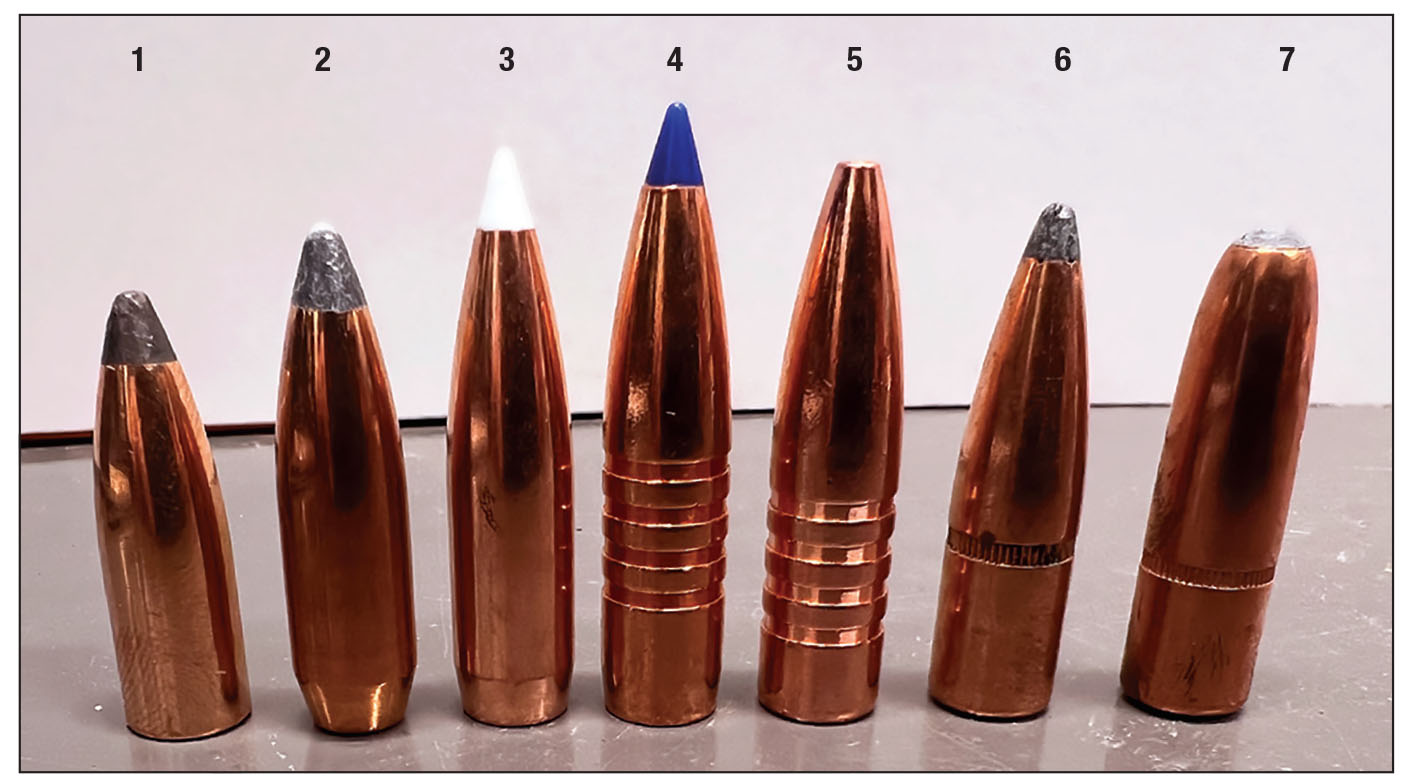
Bullets tested include: (1) Speer 200-grain spitzer softpoint, (2) Speer 225-grain softpoint BT, (3) Nosler 225-grain AccuBond, (4) Barnes 225-grain TTSX, (5) Barnes 225-grain TSX, (6) Hornady 225-grain InterLock SP-RP and (7) Hornady 250-grain InterLock RN.
Now, focusing on gun options for a .338-06 AI, because this cartridge has not been SAAMI approved and still falls into the wildcat category. The .338-06 A-Square was offered in some Remington and Weatherby rifles, but if you want the .338-06 AI, you need to get a custom barrel spun up, chambered and put on to an action by a gunsmith or get the tools to do it yourself. I went the route of taking a Remington 700 ADL with a 22-inch barrel, chambered in .30-06 Springfield, to a gunsmith to ream and chamber it to the .338-06 AI. This was a great option for me as I had a .30-06 hanging out in the safe, so I was able to keep a gun and give it new life. This might be a good option for a lot of people. Most guns chambered in .338-06 A-Square and .338-06 AI use a twist rate of 1:10, but I have seen ones with a 1:9 twist that would help to stabilize the heavy bullets.
When it comes to handloading, I have decided to do brass the economical way; I happen to have a heap of once-fired .30-06 brass. Utilizing these cases means they will need to be fireformed to the .338-06 AI chamber. A lighter or slightly reduced load will accomplish this task. To start, anneal the brass and expand the neck enough to fit a .338 bullet. If a handloader does not anneal the brass before sizing, the once-fired brass is work hardened, which can stress the brass neck and cause it to crack on sizing. Annealing brass also adds life and better neck tension. Once the brass has been full-length sized, check to see if it needs to be trimmed. For some reason, AI cartridges don’t seem to grow like other cartridges. AI brass rarely needs trimming. Once that step is done, it’s time to prime. This was completed on a Forster Co-Ax Press. It’s easy and fast to use and you can feel the primers seat just right.
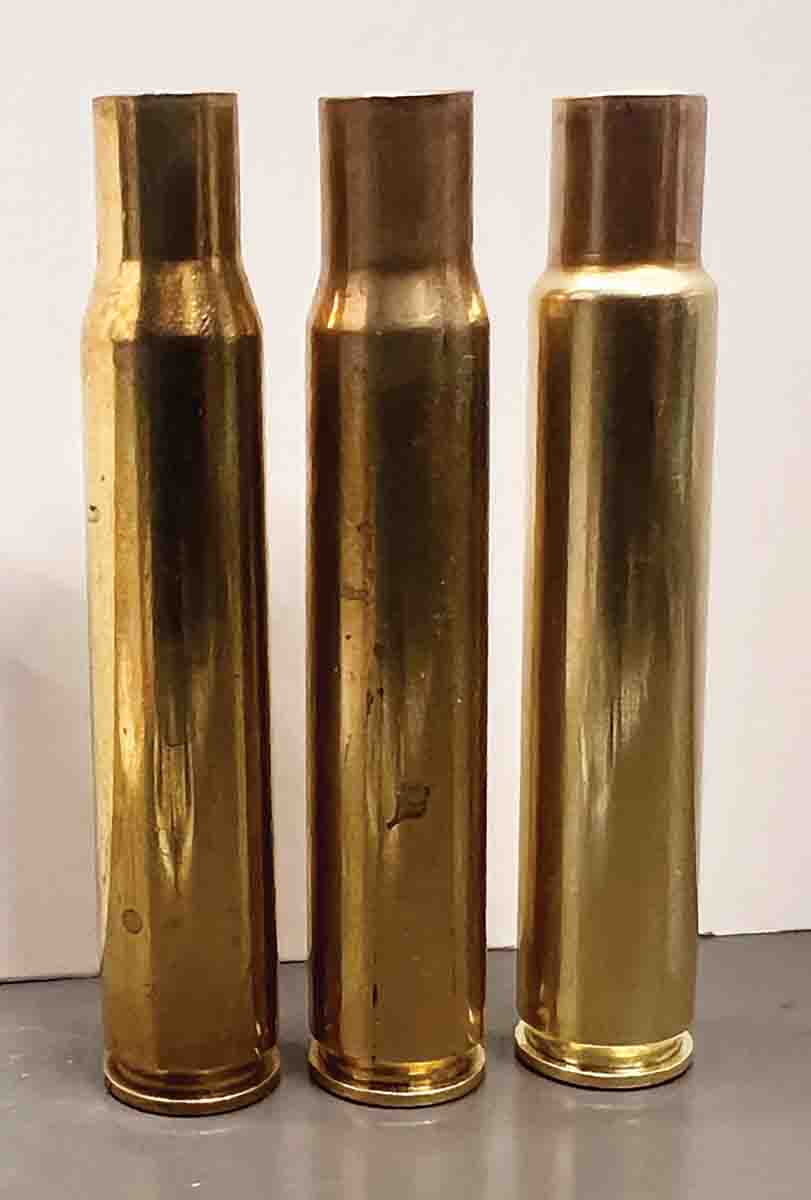
Brass forming from .30-06 to .338-06 AI (left to right): .30-06 brass, .30-06 brass necked-up to fit .338 bullet for fireforming and .338-06 AI brass after fireforming.
The next step is powder. Once the powder is decided on, it is weighed on a Frankford Arsenal Intellidropper. Once the seating die is set, it’s time to seat bullets for fireforming the brass. For this, a hard-cast, 225-grain bullet was used as I was not shooting for groups. A lot of people think this is a waste of components, but I am a firm believer that any time spent behind a gun is never wasted because I am building my skills. Also, we get to go out and shoot, and in my book, that’s never a waste of time. Once I have hit the range to fireform the brass, it’s time to repeat all the steps above again.
There is a good selection of bullets in the .338 line. Barnes offers some great options for hunting, like Triple-Shock X (TSX) bullets .338 caliber, 210-grain hollowpoint boat-tail; Tipped Triple-Shock X (TTSX) bullets .338 caliber, 225-grain spitzer boat-tail; or the LRX Long-Range hunting bullets .338 caliber, 250-grain LRX boat-tail. All of these options are great choices for hunting. The TSX is my main bullet of choice to hunt with if I can get it to shoot around 1 inch out of a hunting rifle. They are lead-free and, in my experience, I have seen these bullets expand and get the job done all the way down to 2,200 fps.
Nosler also offers some great options for hunting, like the AccuBond 180-grain, Expansion Tip (Lead-Free) Ballistic Silvertip 200-grain, AccuBond 225-grain or the AccuBond 250-grain. I personally have great luck on big game using the Ballistic Silvertip bullet. I shot a 600-pound aoudad in New Mexico last summer with that bullet at 357 yards and the performance was amazing. It broke two ribs on entry, a double-lung shot and the bullet broke two more ribs on its way out. I do wish I could have recovered the bullet, but was unable to do so.
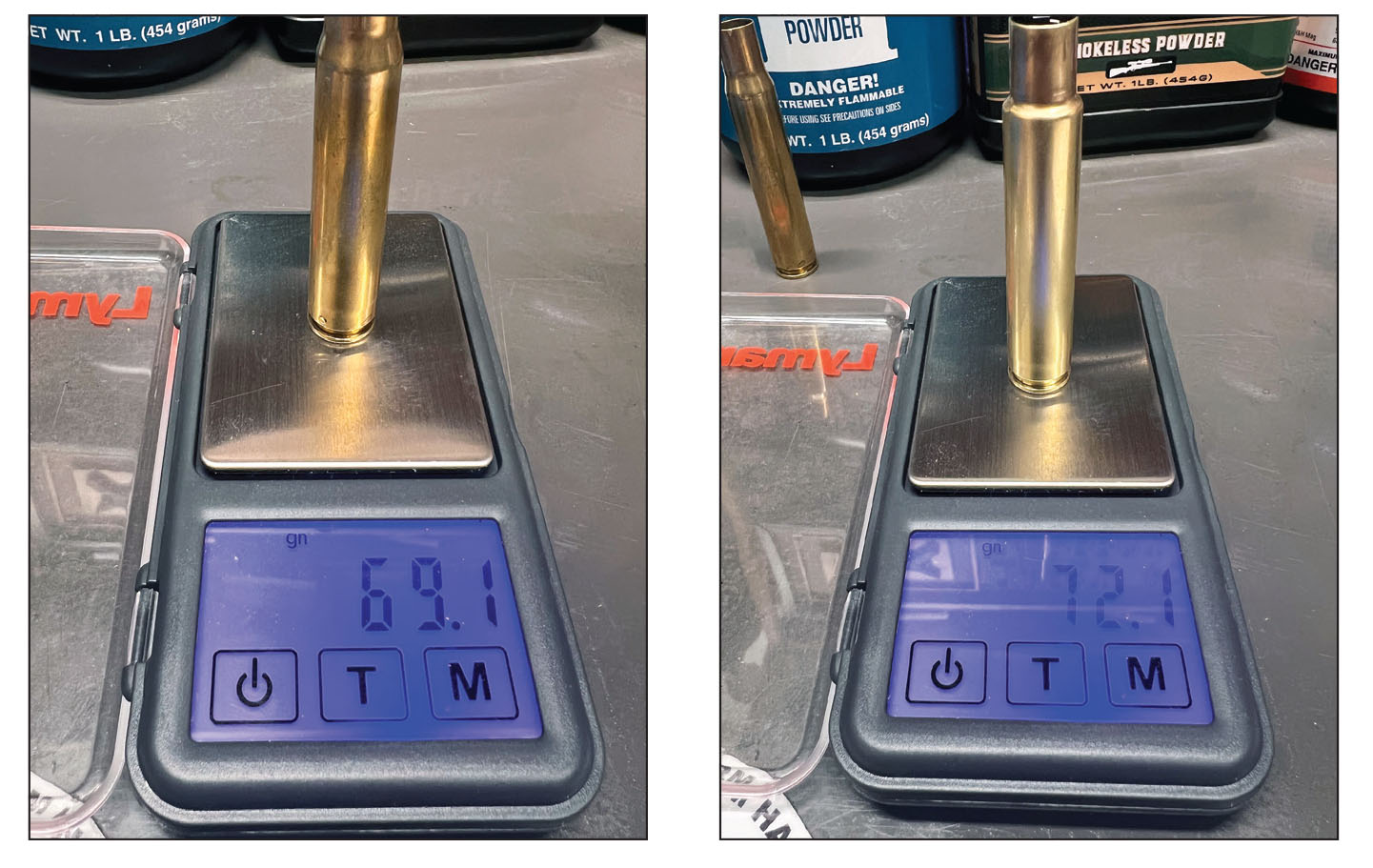
The .338-06 A-Square brass (left) had a water capacity of 69.1 grains while the .338-06 AI (right) had a water capacity of 72.1 grains. Both cases were made by Remington.
Hornady offers a mix of both hunting and target bullets. Hunting bullets like CX bullets polymer-tip, copper-expanding boat-tail (lead-free) is a new bullet that I have not had a chance to test. It is offered in a 185-grain and a 225-grain .338 bullet. Hornady offers a more traditional hunting bullet – the InterLock 225-grain Spire Point and ELD-X Polymer Tipped boat-tail that is becoming more and more popular among long-range hunters.
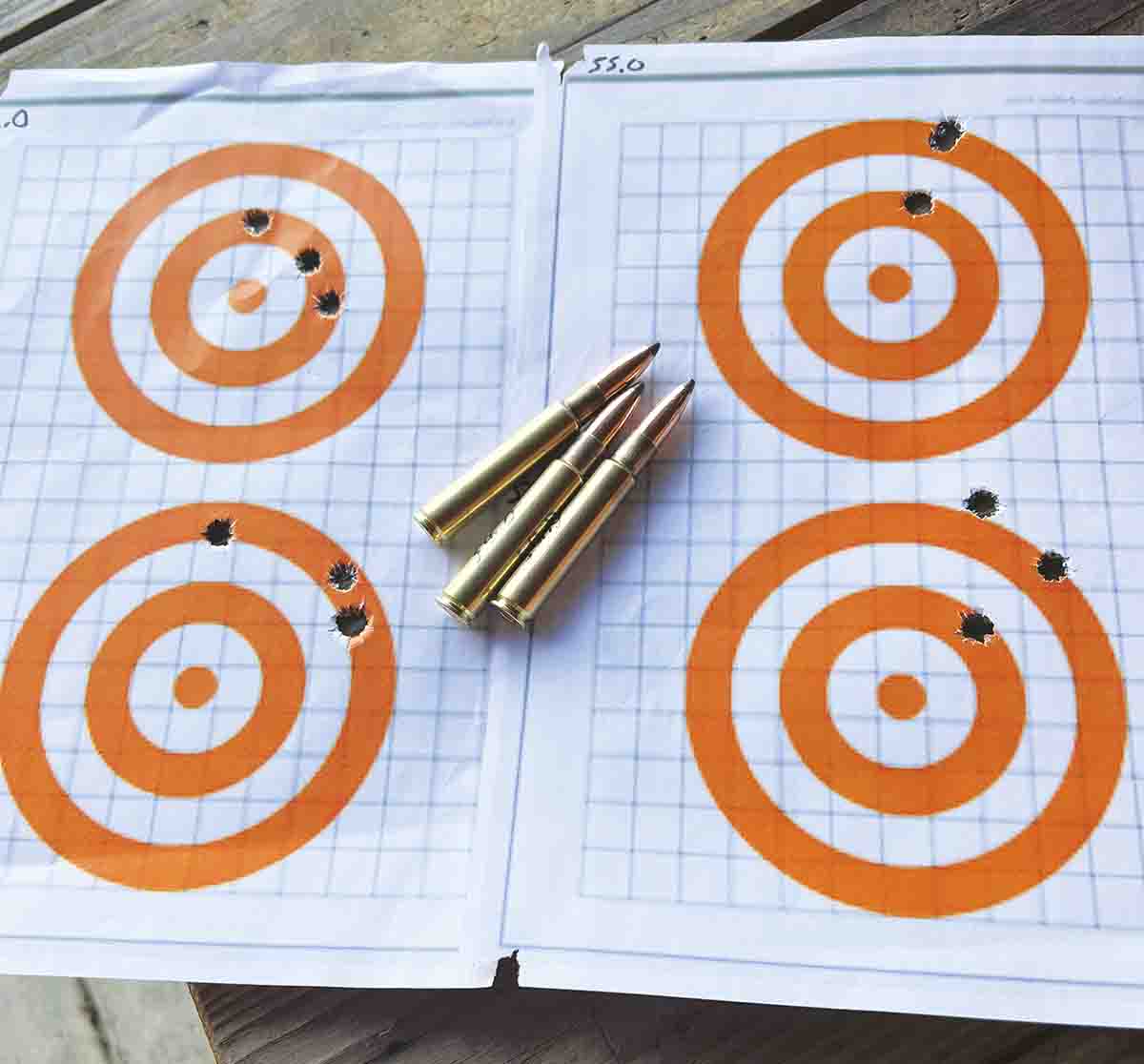
These four range targets were shot using Speer 225-grain softpoint boat-tail bullets. Accuracy may not be match worthy, but it is more than acceptable for hunting at reasonable ranges.
For their more target and precision bullet, they have the ELD-M, which is a great choice for ringing steel. Speer offers three different bullets, all of which I like. Speer’s 200-grain Hot-Cor spitzer is a great, cheaper option (and in my experience, it has been accurate) than the 225-grain spitzer boat-tail and Speer 250-grain Grand Slam bullet.
Right now, primers are like gold, or perhaps they are even more valuable than the precious metal. However, when it comes to this cartridge, I like to use Federal Gold Medal GM210M, but they are getting tough to find.
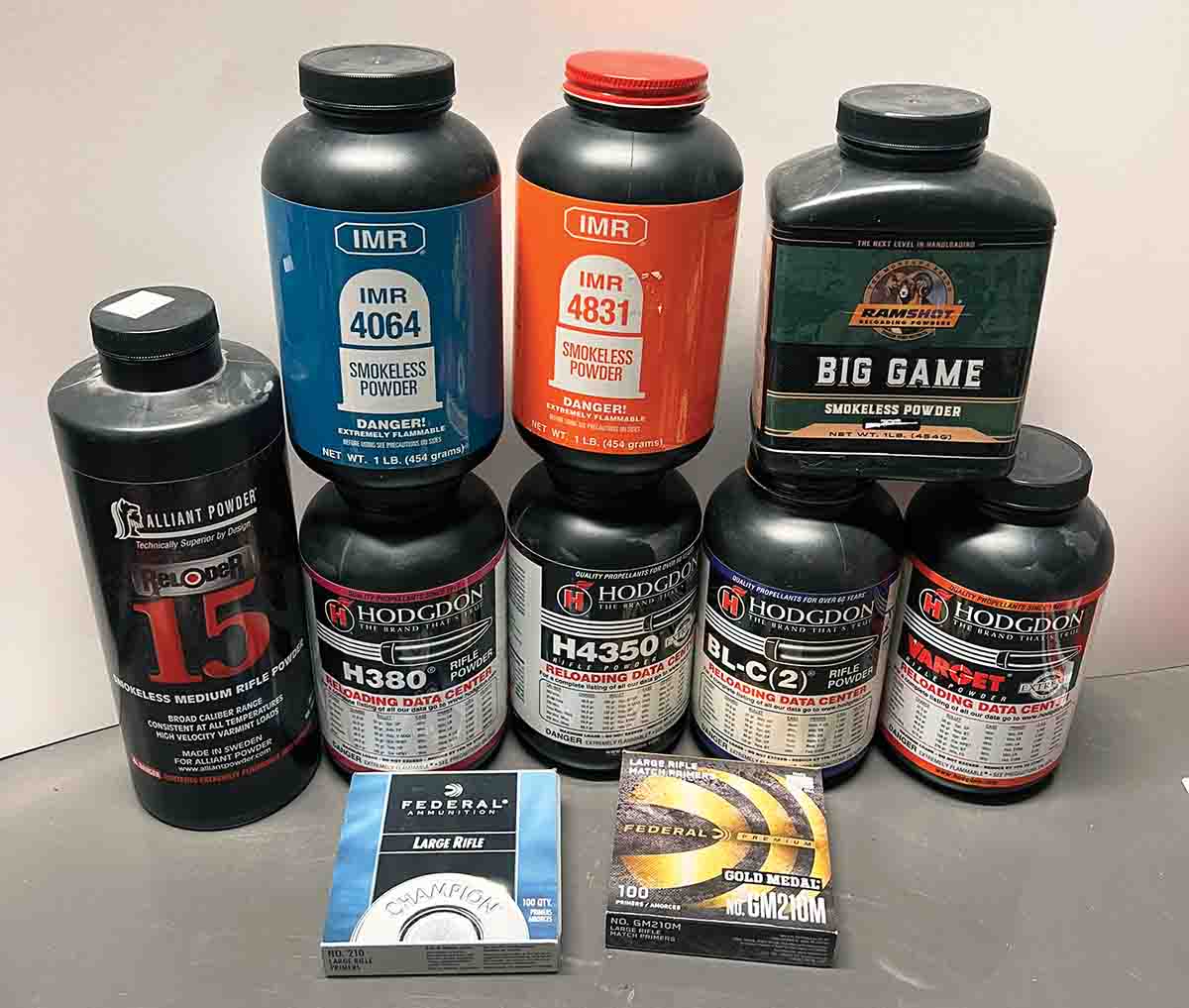
A wide range of powders were used throughout testing.
This cartridge allows shooters to have a good variety of powder options. Here are some of the few I have found to be the best performers: Hodgdon Varget, H-380, H-4350, IMR-4064, IMR-4831, Ramshot Big Game and Reloder 15.
The test rifle is a Remington 700 ADL with a 22-inch barrel and a Leupold M8-4x fixed power scope that weighs 6.5 pounds.
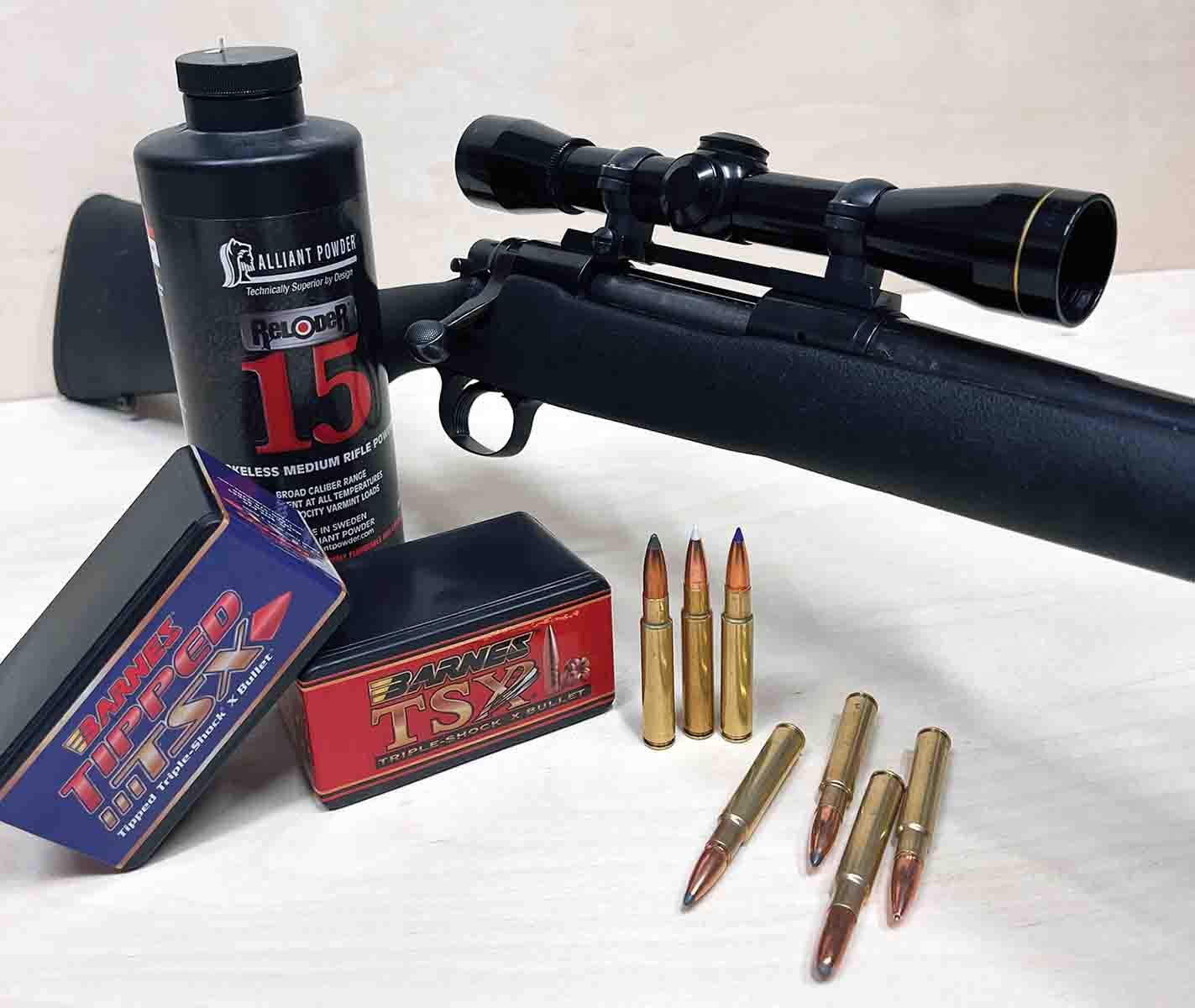
The Remington 700 ADL performed well overall with a wide range of bullets used for testing. A few hunting favorites are shown here.
Testing the 225-grain bullets, they shot best with a slower-burning powder like Hodgdon H-4350 and IMR-4831. Although some of the medium-burn rate powders did well, like Reloder 15 and IMR-4064. I did a lot of testing from 200-grain up to 250-grain bullets with eight different powders and three-shot groups. The best results were with the Nosler AccuBond 225-grain. Shooting an average of a .73-inch group with a muzzle velocity of 2,601 fps average. Velocity was measured with a MagnetoSpeed V3 Ballistic Chronograph.
This is a fun round to load and shoot. It holds its own when put up against magnum cartridges. It has less recoil, yet, still has great energy at reasonable hunting ranges. The downside is that there are no factory rifles chambered in .338-06 AI. For those that have this cartridge, we really know the joys of loading and shooting this cartridge.










.jpg)


